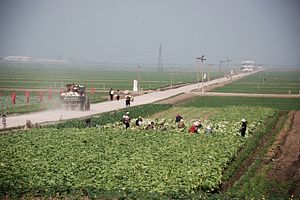In early May, the United Nation’s World Food Program (WFP) and the Food and Agriculture Organization warned that 40 percent of North Korea’s population – 10.1 million people – “are food insecure and in urgent need of food assistance.” In findings based off a two-week fact-finding trip to North Korea, the WFP and FAO report blamed “[p]rolonged dry spells [and] abnormally high temperatures and floods, coupled with limited supplies of agricultural inputs” for a particularly weak harvest last fall, leading to a food shortage in 2019.
The market factor in North Korea’s current food crisis sometimes seems unclear. Some have talked about the market compensating for what the state doesn’t provide in the event of a food shortage. But the WFP’s methodology should cover for that. They calculate not only collective farms yields specifically, but arable land and production in general. Their estimates may (it’s not entirely clear) be based on data for total farmland available provided by the state, and there are some types of plots that wouldn’t be covered in that case. But WFP uses satellite imagery to verify official information on production figures (see page 5 of their rapid food security assessment for North Korea).
We don’t know how big a proportion of the total amount of food produced in North Korea is sold on the markets, and how much is distributed through state and semi-state channels such as enterprises and factories, which are sometimes partially operated privately. In any case, when the WFP measures total harvests, this likely, at the very least, includes most sources for the food that’s sold on markets. So a drop in total production still means lower market supply.
So why are markets still so important to understand food security, and why is it a problem that the WFP cannot access them freely? Rest assured, this is not for a lack of trying. From pp. 6–8 (my emphasis added):
The assessment team also experienced challenges in accessing markets and acquiring market-related data. However, the team was not able to visit farmers’ markets during the field visit. While authorization was granted at national level to visit farmer’s markets, county authorities informed that they were not able to receive any foreign delegation on the day. Market visits are highly recommended to fill this information gap in future assessments. Finally, the team could only gather limited information on people’s incomes and expenditures during the household surveys.
Again, the WFP’s conclusions are still highly relevant and meaningful. But as they themselves recognize, markets are crucial for understanding the microeconomic conditions on the ground in North Korea.
The most important reason, perhaps, is that distribution of food is just as important as food production for food security. As Amartya Sen has shown, food security is often more about who has an “entitlement” to food than about precisely how much food is around. This is where North Korea’s markets come in. Total production is an important metric to be sure, but to really understand how food is distributed, and who gets to eat, we have to also understand precisely how the markets work. We need to understand who uses them and how much they’re able to buy. And prices tell us something about overall supply (though as I have argued, probably not the full story).
Especially in a country like North Korea, where access to food and sustenance is a political matter, distribution (or entitlements) is more important than total food production for food security. The markets are a crucial mechanism for distribution in North Korea. As long as the WFP isn’t allowed to survey them, and to do more extensive household surveys freely in the country, we won’t truly know what food security looks like.
Benjamin Katzeff Silberstein is the co-editor of North Korean Economy Watch and an associate scholar with the Foreign Policy Research Institute.
This post was originally published by North Korean Economy Watch and appears with kind permission.

































